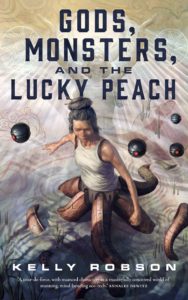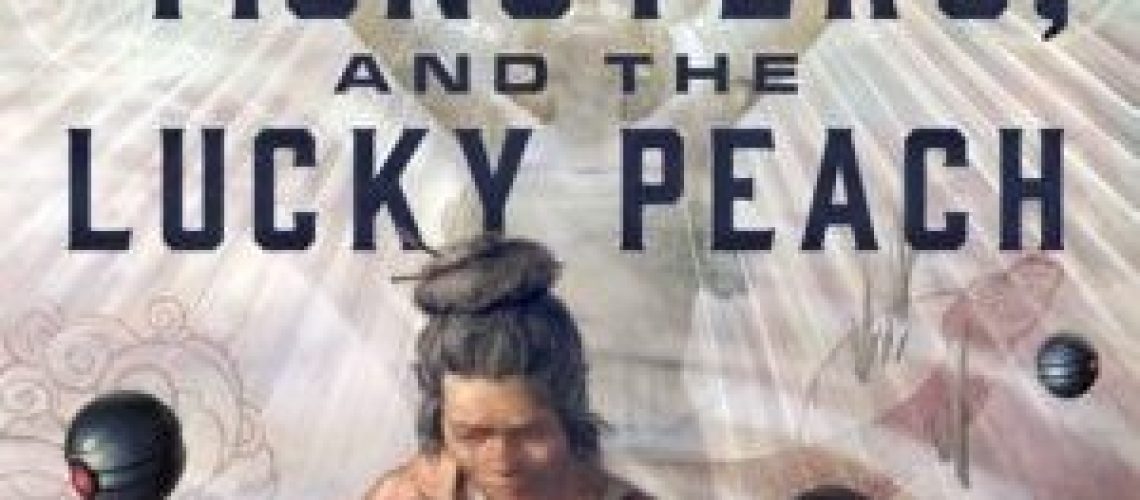Gods, Monsters and the Lucky Peach is Kelly Robson’s successful leap from shorter fiction into novella format, combining new ideas on the uses of a time machine with a strong character-focused milieu and story.
Time Travel is one of the seminal ideas in all of science fiction. Going all the way back to Mark Twain and H.G Wells, traveling outside of one’s own time frame is an idea that has been done and done innumerable times. There have been plenty of novels, stories and movies that explore the idea of time travel, to the past, to the future, to parallel timelines, to alternate worlds. It seems that any long-running science fiction series on television must have a time travel episode. And of course, the longest-running science fiction series in television history is…a show about time travel.

The uses of time travel are pretty standard and are well worn. Time travel by accident. Time travel to steal things from the past and bring them to the present. Time travel to bring people from the past and take them to the present. Time travel as exploitation of the past. Time travel as tourism. Time travel to answer historical questions. And for all of “time and space” to explore time travel in, there are some common places and times for time travelers to wind up in. Rome is pretty common. Ancient Greece. The Dark Ages. The Birth of Christ. Your Grandfather’s childhood.
So what can Kelly Robson do that’s new in her time travel novella Gods, Monsters and the Lucky Peach? Plenty, as it turns out. The novella is set a couple of centuries hence, in a world that is trying to recover from the wreckage of climate change. Climate change has wrecked the world, causing most of the survivors to head to underground fastnesses called hives and hells. In the last decades, people have emerged from these to have a go at living on the surface once more in settlements called habs. These habs have not been entirely successful, and indeed, the future of these habs and their attempts at ecologically restoring areas around them is in jeopardy, as the underground hives and hells are in economic and social conflict with the habs. And the newest wrinkle in this conflict? The invention of time travel.
The protagonists of the novella, Minh, the cyborg ecologist with tentacles instead of legs (that is her on the cover), Hamid, and Kiki together bid for and win a chance to use time travel for a purpose I’ve not seen before in all the time travel stories I’ve read: to help the present’s ecological difficulties by studying ecosystems of the past to provide a baseline of information for restoring the wrecked present. Minh’s plan is to go to Mesopotamia circa 2000 BC to study the river ecosystems there in order to restore them in the present and establish a new hab. Needless to say, this does not go to plan.
The worldbuilding is the best thing in the novella for me, and was a real joy to explore, even in such a relatively short format. It’s a believable, complicated and messy future, full of conflicts, opposed agendas, and a sketch outline of how we got from here, today, to that future, and what it means now. Even better, instead of an eternal stasis that you sometimes find in future societies (or worse, a future perpetually in conflict or revolution), this is a future that is as multipolar in its outlook as the present moment. They have new concerns, new problems, new sides and new opportunities and challenges. I want to know more about this future world.
Beyond the worldbuilding, Robson has come up with a strong set of protagonists.The teacher-student relationship between Minh and her student and apprentice/employee Kiki is strong and interesting. Minh is the voice of experience, having done many ecological projects but nothing new and grand for a long while, seeking a return to the grand projects of her past. Kiki, youthful, ambitious, and determined, who will dare and do much in order to get ahead and make her mark. And Hamid in between them, the stable voice between them with ideas and hopes of his own for the trip.
And I didn’t even mention Fabian, the time-travel guide taking them to ancient Mesopotamia. And I especially didn’t mention Shulgi and Susa. The former is the local king of the region the time travelers are visiting, the latter is Priestess of the Moon. They have a complicated relationship (and the chapters start from their point of view, sometimes temporally disjoined from the main narrative, which provides a thread of foreshadowing to pull readers through the main narrative to find out just what the main characters are doing that Shulgi and Susa are reacting to. It’s an effective literary technique, in a novella already full of excellent writing.
My only major criticism of the excellence in the novella is that it really ends abruptly. There is so much richness of plot and character here that when the ending comes, it comes with a sudden and swift finality. I was prepared for more, to want more. It almost feels like there is a portion of the book missing. The abruptness jarred me.
So, a different sort of future, using time travel for reasons that are not the usual, with a theory of time travel that is uncommonly explored (Source Code is the only one that really comes to mind as a good parallel to Robson’s setup here). Add to that very crunchy worldbuilding and well developed characters? Gods, Monsters and the Lucky Peach proves you can do new and interesting things with time travel. I understand that the author has and will be writing even more in her future time-traveling ecologically devastated world. I look forward to reading them.







